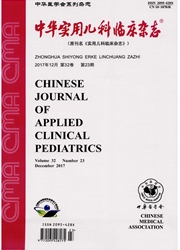

 中文摘要:
中文摘要:
目的分析严重不耐受巯嘌呤(6-MP)的ALL患儿的临床特征,并根据随访结果进一步了解这些患儿停化疗后不良反应的恢复情况。方法选取2004年10月至2007年9月规范应用北京儿童医院-2003-急性淋巴细胞白血病(BCH-2003-ALL)化疗方案的ALL儿童,且处于6-MP维持化疗期间。按NCI—CTCV2.0评价6-MP的不良反应,详细记录出现3~4度不良反应(严重不耐受6-MP)患儿的临床资料和治疗情况,随访至2011年3月31日。结果61例ALL患儿于服用标准剂量6-MP的2~4周出现3—4度不良反应,其中3~4度骨髓不良反应48例(78.7%),包括单纯骨髓不良反应39例(63.9%),同时伴有肝脏不良反应9例。单纯3—4度肝脏不良反应12例(19.7%),1例(1.6%)皮肤3度不良反应。严重不耐受6-MP的不良反应类型与ALL患儿年龄、性别、初诊时白细胞数及中枢侵犯均无明显关系(P=0.605,0.053,0.342,0.983),而与免疫类型和临床危险度密切相关(P=0.039,0.006)。61例ALL患儿随访时间18~77个月(中位随访53个月),5例于治疗18~41个月后复发,其中6-MP维持治疗中复发4例,1例为停化疗5个月后,其余56例患儿均已停化疗,中位停药时间20个月(4.5—47.0个月),存活至今。除1例停药后1年仍轻度贫血,骨髓红细胞系增生不良,其余患儿骨髓不良反应恢复时间12—48周(平均15周),肝功能恢复时间4~25周(平均8周)。免疫功能恢复时间6~12个月,1例皮肤不良反应患儿,停化疗后皮疹4周消失。结论严重不耐受6-MP的ALL患儿近期随访结果表明,骨髓毒性和肝脏毒性是可逆的。这些患儿停化疗后预后良好,均未发现严重的脏器功能不良。但临床需要继续随访这些患儿,进一步了解与6-MP可能相关的第二肿瘤等远期不良反应,以明确严重不耐受6-MP的ALL患儿的远期预后。
 英文摘要:
英文摘要:
Objective To analyze the clinical features of acute lymphoblastic leukemia (ALL)patients with severe intolerance to 6-mercaptopurine (6-MP) , and to profile the recovery following overall chemotherapy completion in these patients according to the follow-up. Methods ALL patients enrolled from Oct. 2004 to Sep. 2007 in Beijing Children's Hospital had received standard BCH-2003-ALL regimen in the study. The chemotherapy was kept at maintenance stage with 6-MP. 6-MP toxicity was scored according to NCI-CTC V2.0, and the grade 3 - 4 toxicity identified as severe 6-MP intolerance. For the patients with severe 6-MP intolerance, the detailed clinical features and response to the treatment were documented and followed up until Mar. 31,2011. Results Sixty-one patients experience grade 3 -4 toxicity to 6-MP, out of which 48 cases (78.7%) had myelotoxicity, consisting of 39 cases with single bone marrow toxicity and 9 cases with bone marrow and hepatotoxicity, 12 cases (19.7%)single grade 3 -4 liver toxicity, and 1 case ( 1.6% ) cutaneous toxicity. The patterns of 6-MP toxicity were not correlated with the age, gender,initial WBC counts, and ALL CNS involvement (P = 0. 605,0. 053,0. 342,0. 983, respectively) , but with immunophenotype and clinical risk degree (P =0.039,0. 006, respectively). All 61 patients were followed up for 18 -77 months with mediate 53 months. Five cases relapsed 18 -41 months after chemotherapy ,with 4 cases during maintenance chemotherapy with 6- MP and one case was in 5 months after whole chemotherapy completion. Fifty-six cases had survived for 4.5 - 47.0 months with mediate 20 months after whole chemotherapy was completed. Except for 1 case with mild anemia a year af- ter chemothe-rapy, all patients with myelotoxicity took 12 -48 weeks (mediate 15 weeks) to recover from 6-MP toxicity, those with hepatotoxicity did 4 - 25 weeks ( mediate 8 weeks), and those with cutaneous toxicity did 4 weeks. Conclusions Most of the patients with severe 6-MP toxicity present my
 同期刊论文项目
同期刊论文项目
 同项目期刊论文
同项目期刊论文
 期刊信息
期刊信息
